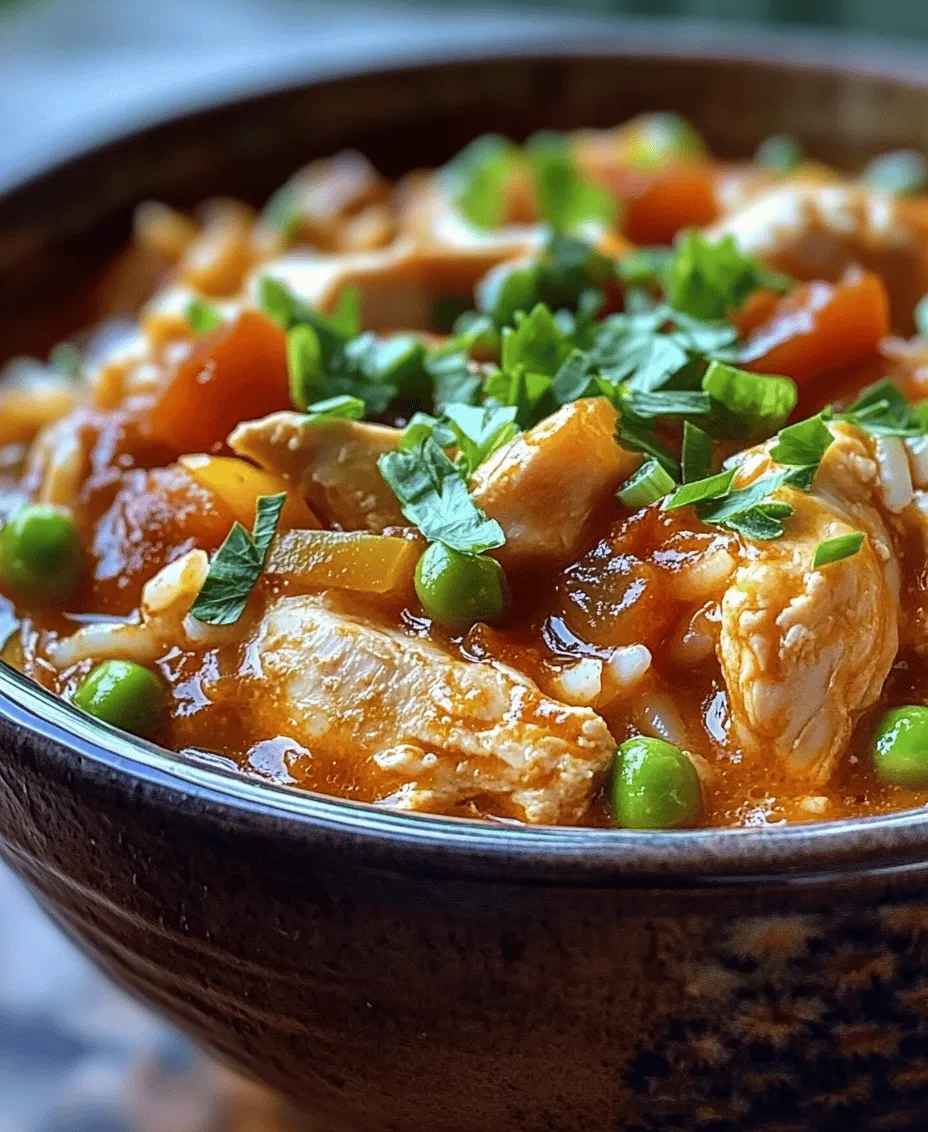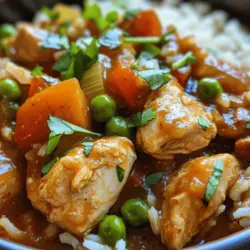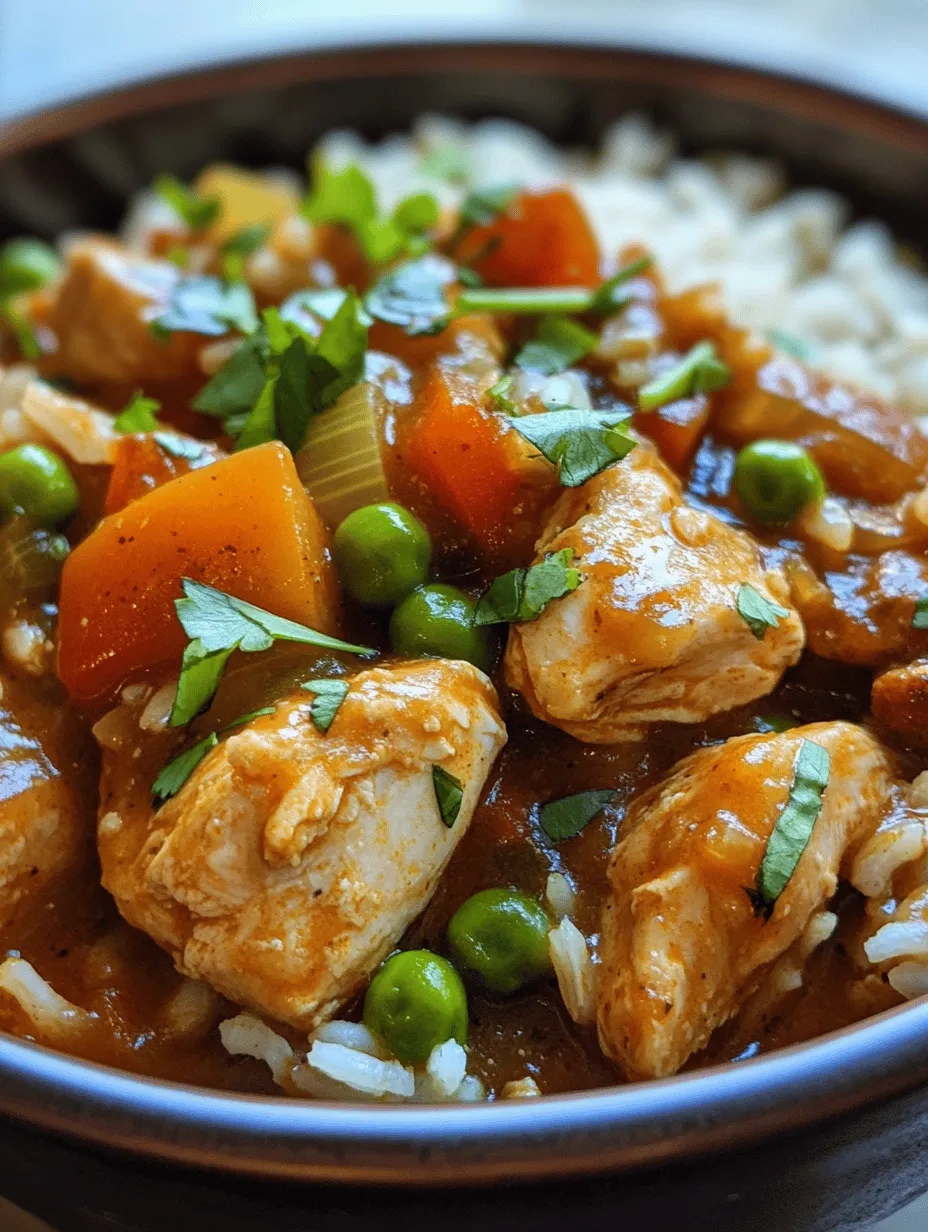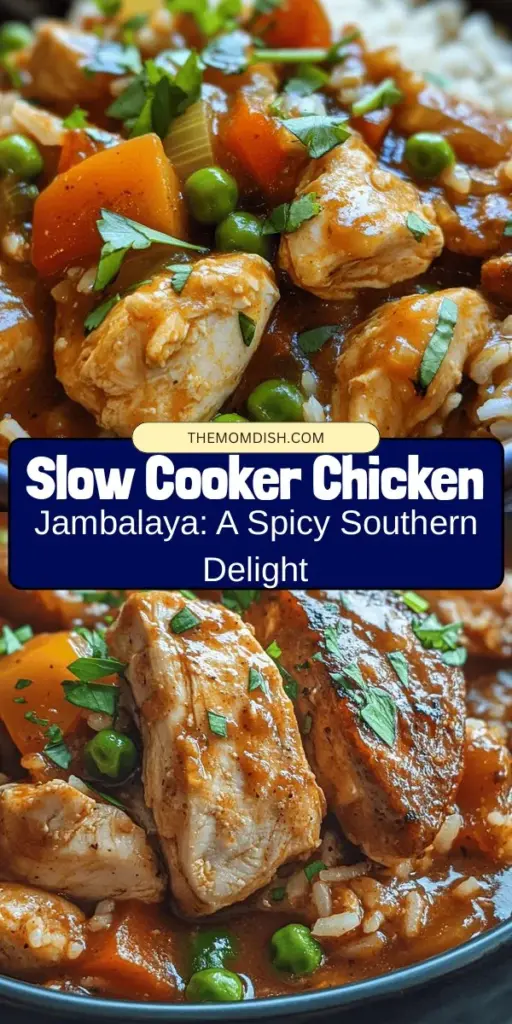Introduction
Jambalaya is a vibrant dish that embodies the heart and soul of Southern cuisine. Originating from the rich culinary traditions of Louisiana, this one-pot meal is a harmonious blend of flavors, textures, and aromas that invites you to savor every bite. Traditionally made with a combination of meat, vegetables, and rice, jambalaya is a versatile dish that has captivated the taste buds of many, whether at a family gathering or a festive celebration.
In today’s fast-paced world, the appeal of slow cooking cannot be overstated. The slow cooker allows busy home cooks to prepare meals with minimal effort while still delivering rich, comforting flavors. The Spicy Slow Cooker Chicken Jambalaya recipe stands out as a quintessential family meal that is not only easy to make but also packed with bold flavors that everyone will love. With its combination of tender chicken, spicy sausage, and a medley of vegetables, this dish is sure to become a staple in your household.
The History and Significance of Jambalaya
The origins of jambalaya are deeply rooted in the Creole and Cajun cultures of Louisiana. This dish is a beautiful representation of the melting pot that is Southern cooking, influenced by Spanish, French, and African culinary traditions. The earliest forms of jambalaya were inspired by the Spanish paella, using similar techniques of cooking rice with meat and vegetables. Over time, jambalaya evolved, and regional variations emerged, leading to the two primary styles we know today: Creole jambalaya, which incorporates tomatoes, and Cajun jambalaya, which omits them.
Each region of Louisiana has its unique twist on this classic dish, often resulting in a multitude of family recipes passed down through generations. Whether it’s the addition of seafood in coastal areas or the incorporation of local spices and herbs, jambalaya is a dish that reflects the diverse cultures and traditions of its origin.
Culturally, jambalaya holds a special place in Southern gatherings. It is often served at celebrations, such as Mardi Gras, weddings, and family reunions, making it not just a meal but a centerpiece for socializing and sharing stories. The communal nature of jambalaya, where everyone can dig in and enjoy together, adds to its significance, making it a beloved dish across the South.
Understanding the Key Ingredients
To create a truly authentic and flavorful spicy slow cooker chicken jambalaya, it’s essential to understand the key ingredients that contribute to its depth and character.
Chicken Thighs
Chicken thighs are the protein of choice for this jambalaya recipe, and for good reason. Unlike chicken breasts, which can dry out during cooking, thighs remain juicy and tender even after prolonged heat exposure. Their rich flavor complements the spices and seasonings used in jambalaya, making them an excellent addition to this hearty dish.
Andouille Sausage
No jambalaya would be complete without andouille sausage. This smoked sausage, which hails from the French heritage of Louisiana, brings a distinct spicy and smoky flavor that elevates the dish. The fat content in the sausage also helps to enrich the overall flavor, as it renders down during cooking, infusing the rice and vegetables with its savory essence.
Vegetables: Onions, Bell Peppers, and Garlic
A classic trio in Cajun and Creole cooking, onions, bell peppers, and garlic form the aromatic base of jambalaya. These vegetables not only provide essential flavors but also contribute to the dish’s overall texture. Onions add sweetness, bell peppers introduce a slight crunch, and garlic brings a pungent, savory note that ties the entire dish together.
Cajun Seasoning and Herbs
The bold flavors of jambalaya come largely from the seasoning. A blend of Cajun spices, often including paprika, cayenne pepper, oregano, thyme, and black pepper, is crucial for achieving that signature spiciness and depth of flavor. Fresh herbs, such as parsley and green onions, can also be added at the end to brighten the dish and add freshness.
Rice
Rice is the binding ingredient in jambalaya, absorbing the flavors of the meat and spices and becoming tender and fluffy as it cooks. Long-grain rice is typically used, as it holds its shape well and doesn’t become mushy. When cooking jambalaya in a slow cooker, the rice takes on the essence of the dish, making it a delicious and satisfying element.
Preparation: How to Create the Perfect Jambalaya
Creating the perfect spicy slow cooker chicken jambalaya requires some preparation, but the process is straightforward and rewarding. Follow these steps to ensure your dish turns out flavorful and satisfying.
Step 1: Prepping the Ingredients
Before diving into the cooking process, gather and prepare all your ingredients. This includes:
– Chicken Thighs: Trim any excess fat and cut the thighs into bite-sized pieces for even cooking.
– Andouille Sausage: Slice the sausage into rounds or half-moons, depending on your preference.
– Vegetables: Dice the onions, chop the bell peppers, and mince the garlic. Having these prepped and ready to go will streamline the cooking process.
Step 2: Seasoning the Chicken
Seasoning the chicken is a crucial step that adds layers of flavor to your jambalaya. Use a generous amount of Cajun seasoning to coat the chicken pieces evenly. This step allows the spices to penetrate the meat, ensuring that every bite is packed with flavor.
Step 3: Layering Ingredients in the Slow Cooker
The beauty of slow cooking lies in the layering of ingredients. Start by placing the seasoned chicken thighs at the bottom of the slow cooker. Next, add the sliced andouille sausage, followed by the diced onions, bell peppers, and minced garlic. This layering technique allows the flavors to meld beautifully as the dish cooks.
Step 4: Adding Rice and Liquid
Once the meat and vegetables are layered, it’s time to add the rice. Pour the long-grain rice over the top of the other ingredients, spreading it evenly. Then, add your choice of chicken broth or stock, ensuring that the rice is fully submerged. This liquid will be absorbed as the rice cooks, creating a flavorful base for the jambalaya.
Step 5: Cooking Time: Low vs. High Settings
Set your slow cooker to low for approximately 6-8 hours or high for 3-4 hours. Cooking on low is ideal for allowing the flavors to develop fully and the chicken to become tender, while the high setting is perfect for a quicker meal. Regardless of the setting, avoid lifting the lid too often, as this releases heat and can affect cooking time.
Step 6: Adding Frozen Peas
About 30 minutes before serving, stir in a cup of frozen peas. This not only adds a pop of color to your jambalaya but also introduces a sweet element that balances the spiciness of the dish. The peas will cook quickly, adding freshness to the overall flavor profile.
As you can see, making spicy slow cooker chicken jambalaya is a delightful culinary adventure that brings together the rich traditions of Southern cooking with the convenience of modern cooking methods. With the right ingredients and preparation techniques, you can create a dish that is both comforting and flavorful, perfect for any family gathering or weeknight dinner. Stay tuned for the next part, where we will delve into the flavor profile of this dish and explore how to balance spice and comfort in every bite.

Understanding Cajun Seasoning and Spice Adjustment
Cajun seasoning is a vibrant and flavorful blend that serves as the heart of authentic Jambalaya. Typically composed of a variety of spices such as paprika, garlic powder, onion powder, black pepper, oregano, thyme, and cayenne pepper, this seasoning adds depth and a signature kick to your dish. Each component of Cajun seasoning plays a crucial role: paprika provides color, garlic and onion powders contribute savory notes, and the herbs lend an aromatic quality.
Cayenne pepper, in particular, is responsible for the heat in the seasoning. However, spice tolerance varies from person to person. If you’re sensitive to heat, consider adjusting the amount of cayenne pepper in your recipe. Start with a small pinch, taste the dish as it cooks, and gradually increase until you achieve your desired level of spiciness. This method not only ensures that the flavors meld beautifully but also allows you to cater the meal to your guests’ preferences.
Tips for Tasting and Adjusting Seasoning Before Serving
As your Spicy Slow Cooker Chicken Jambalaya nears completion, it’s essential to taste and adjust the seasoning. This is a crucial step that can elevate your dish. Use a clean spoon to sample the Jambalaya, and consider the balance of flavors. If it needs more depth, you can add a dash more of Cajun seasoning or a sprinkle of salt. If you prefer a bit more heat, a touch more cayenne or a few dashes of hot sauce can do the trick.
Additionally, remember that flavors can intensify as the dish sits. If you are planning to serve it later, it might be wise to err on the side of slightly under-seasoning during the cooking process. You can always adjust when you reheat the dish.
Garnishing Your Jambalaya
Garnishes are not merely decorative; they serve to enhance both the presentation and flavor of your meal. For Jambalaya, sliced green onions and fresh parsley are ideal choices. The green onions add a crisp, slightly oniony bite that contrasts beautifully with the rich, savory base of the dish. Fresh parsley introduces a touch of brightness and color, making your meal visually appealing.
To garnish, simply sprinkle the chopped green onions and parsley over the Jambalaya just before serving. This final touch not only enhances the look of your dish but also provides a fresh flavor that complements the spices beautifully.
Complementary Sides and Beverages
While Jambalaya is a hearty one-pot meal, pairing it with complementary sides can create a well-rounded dining experience. Consider serving a crisp green salad tossed with a light vinaigrette to balance the richness of the Jambalaya. Cornbread is another classic accompaniment that can soak up the flavorful juices and add a sweet contrast to the spicy dish.
For beverages, a chilled white wine, such as Sauvignon Blanc or a fruity Rosé, pairs excellently with Jambalaya. If you prefer non-alcoholic options, sweet tea or lemonade can provide a refreshing counterpoint to the heat of the dish.
Serving Suggestions
When it comes to serving your Spicy Slow Cooker Chicken Jambalaya, portion sizes are important. Aim for about 1 to 1.5 cups of Jambalaya per serving, which allows for a satisfying meal without overwhelming your guests.
Presenting your Jambalaya in rustic bowls or deep plates can enhance the dining experience. If you’re hosting a gathering, consider serving it family-style in a large, attractive bowl, allowing guests to help themselves. This approach fosters a warm, communal atmosphere that encourages conversation and connection.
Pairing Ideas: Side Dishes and Drinks
To complement your Jambalaya, side dishes that incorporate fresh and light flavors work best. In addition to a salad or cornbread, grilled vegetables or a simple coleslaw can provide a refreshing counterbalance. The crunchiness of coleslaw, particularly, can contrast nicely with the tender chicken and rice.
For drinks, consider a light beer or a refreshing cocktail, such as a mojito, which can enhance the meal without overshadowing the dish’s flavors. Non-alcoholic options, like sparkling water with lime, also work beautifully to cleanse the palate.
Nutritional Information and Health Benefits
Your Spicy Slow Cooker Chicken Jambalaya is not only delicious but also packed with nutrients. This dish typically includes lean chicken, bell peppers, tomatoes, and rice—all of which contribute to a well-balanced meal.
– Key Nutrients:
– Protein: The chicken provides a good source of lean protein, essential for muscle repair and overall health.
– Vitamins: Bell peppers are rich in vitamins A and C, crucial for immune function and skin health.
– Carbohydrates: Rice serves as a source of energy, making this dish hearty and filling.
Making the Recipe Healthier
If you wish to make your Jambalaya even healthier without sacrificing flavor, consider these tips:
– Lean Cuts: Use skinless chicken breast instead of thighs to reduce fat content.
– Brown Rice: Substitute white rice with brown rice for added fiber and nutrients, although it may require a slight adjustment in cooking time.
– Vegetable Boost: Increase the quantity of vegetables like zucchini, carrots, or spinach to add volume and nutrients.
Storage and Reheating Tips
Proper storage of your Jambalaya is vital for maintaining its flavor and texture. Allow the dish to cool completely before transferring it to an airtight container. Jambalaya can be stored in the refrigerator for up to four days or frozen for up to three months.
When reheating, the best method is to do so gently on the stovetop over medium-low heat. Add a splash of chicken broth or water to prevent sticking and help restore moisture. Stir occasionally and heat until warmed through. Alternatively, you can reheat individual portions in the microwave, adding a little liquid to keep the rice from drying out.
Ideas for Repurposing Leftovers
Leftover Jambalaya can be a delightful base for new meals. Consider transforming it into:
– Stuffed Peppers: Hollow out bell peppers and fill them with Jambalaya for a colorful and nutritious dish.
– Jambalaya Soup: Add broth to your leftovers for a hearty soup perfect for a winter evening.
– Frittata: Incorporate leftover Jambalaya into a frittata for a unique breakfast or brunch option.
Conclusion
Spicy Slow Cooker Chicken Jambalaya is a versatile and hearty meal that invites creativity in both preparation and serving. With its rich flavors and comforting textures, this dish is perfect for family dinners or casual gatherings with friends. The joy of sharing homemade meals is immeasurable, and Jambalaya, with its vibrant colors and bold flavors, is sure to impress.
As you explore variations, consider experimenting with different proteins such as shrimp or sausage, or even going vegetarian by incorporating beans and an array of vegetables. Each adjustment allows for a unique twist on this classic dish. Embrace the spirit of Cajun cooking, and enjoy the warmth and community that comes from sharing delicious food with loved ones.



